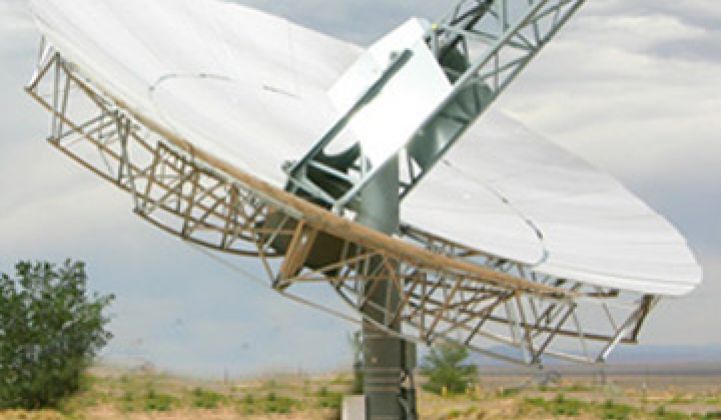Stirling Energy and Tessera Solar, which had hoped to build over a gigawatt of capacity in California, got some more bad news today.
Southern California Edison cancelled the agreement to purchase power from the proposed Calico solar thermal plant, which was supposed to have created 663 megawatts of power.
Stirling, which has created a mirrored dish combined with a Stirling engine that can generate 25 kilowatts of power, and Tessera, its developer, have been in a tailspin this month. Stirling CEO Steve Cowman and other executives departed and layoffs had occurred at Tessera. Right after that, NTR, the Irish parent company of both, said it would no longer invest in the projects.
Then, after that, a judge ruled in favor of an Native American tribe and slapped an injunction on the Imperial Valley project, which would have produced over 700 megawatts of power for San Diego Gas & Electric.
What will happen next? Speculation has been percolating that someone like NRG or First Solar would buy the projects and convert them into solar module parks, scrapping the solar thermal technology angle all together. The lawsuit and the cancelled purchase agreement certainly don't help.
The problem? Solar thermal plants aren't as attractive as they were in 2007. Back then, solar thermal was the technology of choice for big solar parks. Declining prices of silicon and silicon solar panels, however, have caused developers and utilities to switch over to building these with PV panels.
In 2010, the price to build a solar thermal park runs between $4.00 and $6.55 per watt. On the other hand, utility-scale solar module projects can squeak through at less than $3.50 per watt, as we noted in an article in October. One of the big symbols of this shift came when First Solar took over a project from thermal specialist Ausra in 2009 and turned it into a PV project. .
Solar thermal could make a comeback. Thermal plants can produce large amounts of power consistently. Some also argue that the grid has an easier time taking power from large thermal plants than from thousands of independent solar panel installations. Many solar thermal plants can also produce heat after the sun goes down, because heat, unlike light or electricity, can be stored economically.
And the price could go down. BrightSource Energy, one of the more successful solar thermal startups, says it will be able to produce power profitably. Still, the circumstances at the moment and the cost/trend lines favor PV.
Stirling and Tessera, though, also needed millions in equity investments and big honking loans from the government and others.
Ugh is the technical financial term for that situation.
Stirling engines also tout more moving parts than other solar thermal technologies and, unlike most other solar thermal technologies, cannot inherently store heat. Still, right now, price rules and solar thermal is not in favor like it once was.



